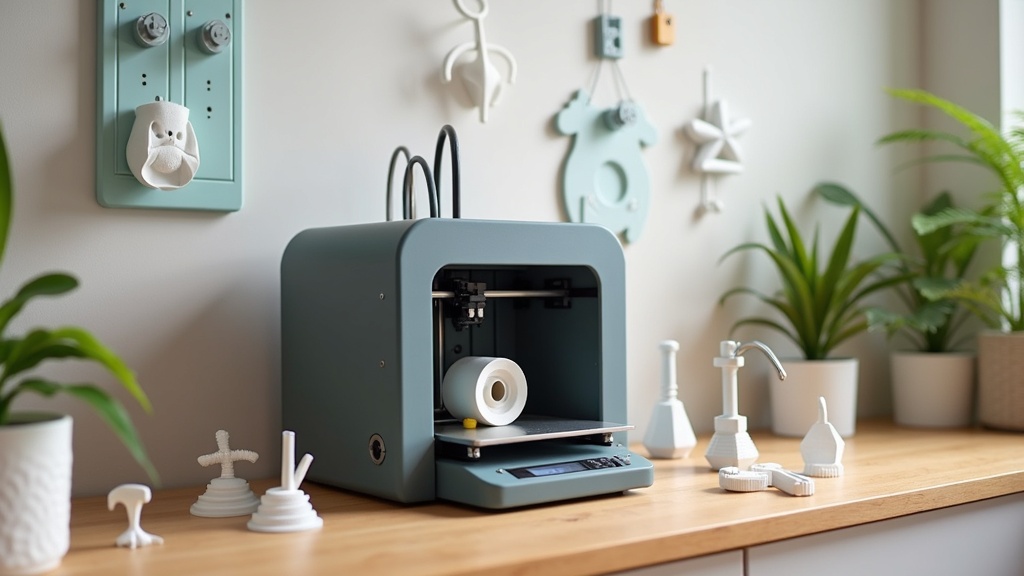3D printing at home has quickly become one of the most practical technologies for solving everyday problems. When something breaks, gets lost, or just doesn’t fit quite right, I find my 3D printer often comes to the rescue. Gadgets, adapters, and custom replacements that used to require a trip to the store or an online order can often be produced right from my workbench in a few hours or less. Here, I want to share ten common household problems you can address today with your own 3D printer.

Tackling Everyday Annoyances with 3D Printing
Having a 3D printer at home means I can handle many small issues without searching endless hardware lists. Replacement parts, clever hooks, or even custom organizers are right at my fingertips. The cost of a spool of filament and some time designing or downloading a file frequently saves me both money and hassle compared to finding specialty goods or waiting for delivery.
Many homes, including mine, have little frustrations like broken drawer handles, cables running everywhere, or lost board game pieces. Traditional solutions often involve a patch job or making do, but 3D printing gives me a better, longer-lasting fix that fits exactly as needed.
Since 3D printing technology became affordable for personal use, online communities like Thingiverse and Printables have exploded with designs for practical, real-world items. This means I rarely have to create something from scratch. With only basic printer knowledge and internet access, I can browse and print objects in almost any category.
What You Need to Get Started with Home 3D Printing
Before you can print your first fix, it helps to learn about what a 3D printer is and what it can do. Most household 3D printers use a method called fused filament fabrication (FFF). This process involves melting plastic filament and precisely placing it layer by layer to form a solid object. Filament comes in several materials, but PLA is the most common and easiest for beginners.
- 3D Printer: Even entry-level models can print useful objects for the home. They often come with safety features and intuitive controls.
- Filament: PLA works well for most indoor uses, and there are specialty filaments for higher temperature or stronger parts.
- Design Files: Free 3D models can be downloaded from websites, or you can design your own with basic CAD tools like Tinkercad.
Once I get the basics down, the real fun is in figuring out which problems I can solve today. Here are ten issues I’ve personally fixed using my 3D printer, along with tips for anyone new to this hobby.
Quick List: 10 Household Problems You Can Fix with a 3D Printer
- Missing Cabinet or Drawer Handles
Broken or missing handles never look good and make opening things awkward. I print new handles designed to match the screw spacing, shape, and color of my furniture. This avoids mismatches in style or hunting down old hardware. - Scattered Charging Cables
Cable management can quickly get out of control, especially if you have phones, tablets, and headphones. I print custom cable clips or holders that stick behind my desk or along walls, keeping everything sorted and tangle-free. - Door Stoppers and Bumpers
Doors banging into walls leave marks or even holes over time. When I need a door stop instantly, I just print one in rubbery TPU or softer PLA, with exactly the right thickness and shape for the space. - Replacement Board Game Pieces
Losing a Monopoly hotel or Scrabble letter used to mean searching for a new set or using a stand-in. Now, I 3D print spares based on free designs. Some projects even let me customize the colors or add a name for fun. - Clips, Latches, and Small Tool Parts
When I lose a vacuum cleaner clip or a small latch from a storage bin, I measure the broken part and print a new one. Sometimes it takes a few tries to get the fit right, but it beats replacing the whole item. - Organizers for Drawers and Desks
Messy drawers make it impossible to find anything quickly. I print drawer organizers and trinket trays tailored to specific items, so everything stays neat and easy to spot. - Light Switch and Outlet Covers
If covers crack or new paint leaves them looking worn, I download a fresh design and print covers with different styles or patterns. This adds a nice personal touch to rooms without extra cost. - Plant Pots and Holders
I like growing herbs and flowers, but store-bought planters never match my shelf space exactly. 3D printing custom pots lets me choose the shape, size, and drainage style I want for each plant. - Curtain or Shower Rings
If I snap a ring while hanging curtains or a shower liner, making a replacement is a quick project. This also lets me match old rings in color and thickness, so everything looks uniform. - Custom Hooks and Wall Hangers
Hanging keys, kitchen utensils, or decorations is simpler with the right hooks. When hardware store sizes don’t fit my space, I just print hooks for the exact job, whether they’re thick for brooms or slim for jewelry.
Tips to Get Better Results from Your Home 3D Printer
Making household fixes with a 3D printer is rewarding, but there are a few things I do to make sure my projects last:
- Pick the Right Filament: PLA is great for most indoor objects, while PETG or ABS resist heat and stress better if you need more strength.
- Check Sizing and Fit: Measuring the space or broken part before printing saves time. If you’re unsure, start with a thin print and tweak the design as needed.
- Adjust Print Settings: Use more “infill” or extra walls for stronger items like handles or latches. For light items, low infill keeps prints fast and filament usage down.
- Try Flexible Materials When Needed: For door stoppers and bumpers, using a flexible filament like TPU prevents scratching and absorbs impacts better than rigid plastics.
- Finish and Sand When Needed: For items children will touch or for a polished look, sanding rough edges or painting decorative parts can add the final touch.
If you’re new to 3D printing, don’t be afraid to experiment. Trial and error is part of learning. There’s a large online community happy to help troubleshoot problems, make suggestions on print settings, and even share their personal tips for stronger, more reliable printed parts. Also, maintenance is important; regular cleaning of your printer, keeping everything lubricated, and storing filament properly help ensure consistent print quality and long machine life.
Other Creative and Unexpected Uses Around the House
Beyond obvious fixes, I’ve found some eye-catching and unexpected uses for my home 3D printer:
- Custom cookie cutters for themed baking projects
- Battery organizers or remote holders for the living room
- Replacement chess and game pieces, fully customized
- Bird feeders and garden markers for outdoor fun
- Mini tool holders fixed directly under shelves or cabinets
- Key holders shaped like animals or creative hooks for kids’ backpacks
- Personalized gifts such as nameplates or phone stands for family and friends
- Simple repairs for toys, such as wheels or snap-on pieces that commonly break
- Brackets for hanging up small houseplants or adding extra storage in tight spots
- Custom-fit stands or holders for kitchen gadgets that don’t fit standard racks
These projects use up filament scraps and make quick, satisfying prints. Sometimes, they solve problems I didn’t even realize I had until stumbling upon a clever design shared by another maker online.
Frequently Asked Questions About 3D Printing for Household Repairs.
Here are questions I hear often from friends curious about using a 3D printer at home:
Can 3D-printed parts really hold up as well as store-bought ones?
Answer: For many household tasks, a well-printed part will last as long as a plastic store-bought piece. Using proper settings, reinforcing stress points, and selecting the right filament make a big difference in durability.
How do I find the files I want to print?
Answer: Search for free files on popular sites like Thingiverse, Printables, or MyMiniFactory. Many designs include community ratings, instructions, and photos from others who have printed them.
Question: Do I need special skills to make my own designs?
Answer: Beginners can use free web-based design tools like Tinkercad, which offer step-by-step tutorials. For custom parts, carefully measuring the object and following an online guide helps create files that fit your specific needs.
Looking Ahead: 3D Printing’s Growing Role in the Home
Having a 3D printer at home means I rarely get stuck with a missing part or awkward fix-it job. As more people see the value in making rather than buying, 3D printing continues to grow in popularity. Free design-sharing and easy-printing programs make solving daily frustrations much faster. With a little practice, tackling household problems with a desktop 3D printer can be both a hobby and a way to keep my home running smoothly.
Trying new projects, sharing prints with friends, and making upgrades helps put creativity to work all over the house. If you’re willing to check out new ideas and put your printer to use, you’ll stumble upon solutions that keep your space unique, organized, and full of next-level cool creations.

